Scenes from the Battle of Seattle
Report and photos by Liz Highleyman
11/30/99
Tuesday, November 30 -- termed N30 by anti-WTO activists --
dawned gray and cloudy as I made my way up Pike Street to Victor
Steinbrueck Park on the Seattle waterfront. By the time I arrived at
7:00 a.m., over 1,000 demonstrators had gathered, ranging from
environmentalists to union members to advocates for human rights for
the people of Tibet.
Soon the crowd began to march toward the Seattle Convention
Center, site of the long-awaited meeting of the World Trade
Organization, a group of government representatives who set the
international rules regarding trade and tarriffs. WTO delegates were
scheduled to attend an opening ceremony that morning at the historic
Paramount Theater at 8th and Pine, but protesters were determined to
ensure that WTO business did not proceed as usual.
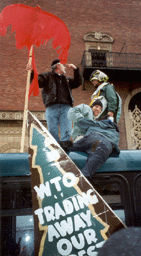
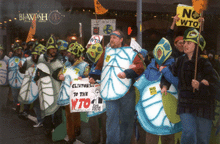 As delegates arrived, demonstrators -- some dressed in sea
turtle costumes and others carrying giant puppets -- formed a human
barrier to deny them entry. Many began to climb on top of the Metro
buses that Seattle police had parked end-to-end around the
theater. Amazingly, authorities had neglected to secure a protected
means of entry for the delegates who began streaming toward the
theater individually and in small groups. This was to be the first
sign that city officials were woefully ill-prepared for what was to
come in the hours and days to follow.
As delegates arrived, demonstrators -- some dressed in sea
turtle costumes and others carrying giant puppets -- formed a human
barrier to deny them entry. Many began to climb on top of the Metro
buses that Seattle police had parked end-to-end around the
theater. Amazingly, authorities had neglected to secure a protected
means of entry for the delegates who began streaming toward the
theater individually and in small groups. This was to be the first
sign that city officials were woefully ill-prepared for what was to
come in the hours and days to follow.
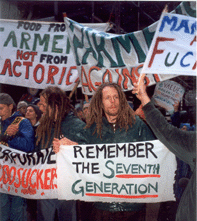 Several affinity groups -- small groupings of ten or so people
determined to interfere with the WTO meeting by means of direct action
-- stationed themselves in major downtown intersections around the
meeting sites, in some cases locking their arms together inside wire
tubes or chaining themselves to makeshift platforms. About 100 others
settled in for a sit-in outside the Sheraton convention center hotel
at 6th and Pike. Along with the many protesters who would not have
looked out of place at an anti-war demonstration three decades ago,
there was 50 to 100 protesters clad in hoods and bandanas, accompanied
by a small marching band wearing matching pink gas masks. From my
15-year acquaintance with the anarchist movement, I recognized the
"black bloc," a direct action tactic adopted from Germany in the
1980s; several of the anarchists joined the sit-in, facing off against
a line of cops in full riot gear.
Several affinity groups -- small groupings of ten or so people
determined to interfere with the WTO meeting by means of direct action
-- stationed themselves in major downtown intersections around the
meeting sites, in some cases locking their arms together inside wire
tubes or chaining themselves to makeshift platforms. About 100 others
settled in for a sit-in outside the Sheraton convention center hotel
at 6th and Pike. Along with the many protesters who would not have
looked out of place at an anti-war demonstration three decades ago,
there was 50 to 100 protesters clad in hoods and bandanas, accompanied
by a small marching band wearing matching pink gas masks. From my
15-year acquaintance with the anarchist movement, I recognized the
"black bloc," a direct action tactic adopted from Germany in the
1980s; several of the anarchists joined the sit-in, facing off against
a line of cops in full riot gear.
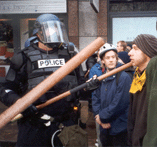
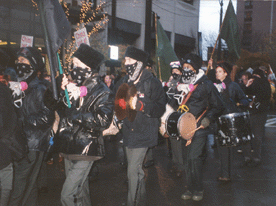 Around 10:00 a.m., the demonstrators got louder and the police
appeared nervous. Some protesters tipped newspaper boxes into the
street to form makeshift barricades and began banging on them with
sticks. Soon a small tank dubbed "the peacekeeper" pulled up behind
the line of riot police. With no apparent provocation, the first of
many cannisters of tear gas flew toward the crowd.
Around 10:00 a.m., the demonstrators got louder and the police
appeared nervous. Some protesters tipped newspaper boxes into the
street to form makeshift barricades and began banging on them with
sticks. Soon a small tank dubbed "the peacekeeper" pulled up behind
the line of riot police. With no apparent provocation, the first of
many cannisters of tear gas flew toward the crowd.
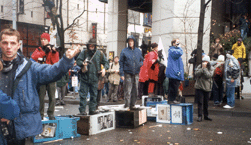 Some of the protesters had come prepared with goggles and gas
masks, while others covered their noses and mouths with bandannas
soaked in vinegar or baking soda. Many more, not expecting to be
gassed and unsure what was happening, panicked and tried to flee the
spreading cloud of gas and smoke. People with tears streaming down
their faces sought shelter in the doorway of an FAO Schwartz store as
others rinsed their eyes and burning skin with water. During a break
in the melee, I picked up several quarter- and half-inch rubber
pellets which police had shot at the crowd; as I would later see, the
pellets cause large bruises and can break teeth and penetrate skin at
close range.
Some of the protesters had come prepared with goggles and gas
masks, while others covered their noses and mouths with bandannas
soaked in vinegar or baking soda. Many more, not expecting to be
gassed and unsure what was happening, panicked and tried to flee the
spreading cloud of gas and smoke. People with tears streaming down
their faces sought shelter in the doorway of an FAO Schwartz store as
others rinsed their eyes and burning skin with water. During a break
in the melee, I picked up several quarter- and half-inch rubber
pellets which police had shot at the crowd; as I would later see, the
pellets cause large bruises and can break teeth and penetrate skin at
close range.
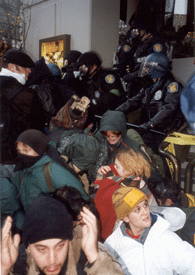 Since the early-1990s, I had largely "retired" from direct
activism and focused my energies on writing; having traded in my
scruffy leather jacket for a North Face rain parka, I had come to
Seattle to cover the events as a freelance journalist. As the gassing
and shooting started, though, I began to think that my first aid
training would prove more useful. I had been a volunteer "medic" at
large events such as gay pride parades and pro-choice marches before,
but had never had to do more than apply a bandaid to a blister. Such
was not to be the case this week.
Since the early-1990s, I had largely "retired" from direct
activism and focused my energies on writing; having traded in my
scruffy leather jacket for a North Face rain parka, I had come to
Seattle to cover the events as a freelance journalist. As the gassing
and shooting started, though, I began to think that my first aid
training would prove more useful. I had been a volunteer "medic" at
large events such as gay pride parades and pro-choice marches before,
but had never had to do more than apply a bandaid to a blister. Such
was not to be the case this week.
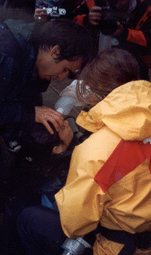 The tear gas used by the Seattle police -- CS gas, or
O-chlorobenzalmalononitrile -- is actually a cloud of tiny crystals
that irritate the mucous membranes. It causes the eyes to water, burns
the nose and throat, and its acrid odor leaves a bitter taste in the
back of the mouth. Those who come into contact with the gas -- even a
block away from where it was dispensed -- may be blinded and find it
hard to breathe; some also vomit. Flushing the eyes with water or a
saline solution is the best immediate remedy. Rubbing the eyes -- most
people's natural reaction -- only makes the burning worse.
The tear gas used by the Seattle police -- CS gas, or
O-chlorobenzalmalononitrile -- is actually a cloud of tiny crystals
that irritate the mucous membranes. It causes the eyes to water, burns
the nose and throat, and its acrid odor leaves a bitter taste in the
back of the mouth. Those who come into contact with the gas -- even a
block away from where it was dispensed -- may be blinded and find it
hard to breathe; some also vomit. Flushing the eyes with water or a
saline solution is the best immediate remedy. Rubbing the eyes -- most
people's natural reaction -- only makes the burning worse.
Some protesters who were equipped with goggles and gas masks
stayed on the front lines and lobbed gas cannisters back at the
police. Other enraged protesters began to throw bottles and other
small debris. As the police kept themselves occupied facing off
against the large crowd, fewer than 50 protesters -- including several
in hoods and masks -- vented their rage at the face of corporate
America in a more direct way. Sticks, boots, manhole covers and
newspaper boxes were used to smash store windows, and facades were
spray-painted with the anarchist circle-A and anti-capitalist
slogans. Damage was targeted at corporate monoliths such as McDonalds,
Old Navy, and Niketown, accused of environmental destruction and the
use of sweatshop labor. The majority of demonstrators opposed the
vandalism, with some attempting to physically restrain or stand in the
way of those carrying it out.
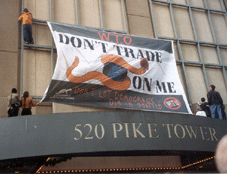 Many demostrators, newscasters, and politicians would lament
in the days and weeks to followed that the violent actions of a few
marred the message of the many. Ironically, the anti-corporate and
anti-technology message of the militant anarchists was undermined in
turn when a small number of local youths not initially involved with
the anti-WTO protests looted the damaged storefronts, making off with
armloads of Nike logo merchandise, cell phones, and small electronics
equipment.
Many demostrators, newscasters, and politicians would lament
in the days and weeks to followed that the violent actions of a few
marred the message of the many. Ironically, the anti-corporate and
anti-technology message of the militant anarchists was undermined in
turn when a small number of local youths not initially involved with
the anti-WTO protests looted the damaged storefronts, making off with
armloads of Nike logo merchandise, cell phones, and small electronics
equipment.
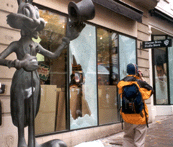 A midday, a large march of over 20,000 labor unionists and
supporters met up with the ongoing downtown demonstration after
marching from a rally at a stadium several blocks away. This new
influx swelled the crowd to some 50,000. Indeed, the incoming march
was so large that it was forced to separate into smaller columns to
approach the convention center. Demonstrators were euphoric when word
spread through the crowd that the morning's actions had resulted in
the cancellation of the WTO's opening ceremonies.
A midday, a large march of over 20,000 labor unionists and
supporters met up with the ongoing downtown demonstration after
marching from a rally at a stadium several blocks away. This new
influx swelled the crowd to some 50,000. Indeed, the incoming march
was so large that it was forced to separate into smaller columns to
approach the convention center. Demonstrators were euphoric when word
spread through the crowd that the morning's actions had resulted in
the cancellation of the WTO's opening ceremonies.
Despite the anti-technology sentiments of some of the
protesters, modern technology was highly in evidence. Much of the
networking and planning necessary to gather so many activists from so
many disparate movements had been carried out using the Internet. At
times, it appeared that there were as many people photographing,
recording, and videotaping the activities as there were
participants. Mainstream Seattle media broadcast live for hours, and
an Independent Media Center marshalled volunteer journalists and
videographers to get non-corporate-controlled information out over the
radio and the Web. It was easy to tell when some excitement was taking
place in a surrounding area, as a chorus of ringing cell phones
alerted organizers to mobilize their forces elsewhere or summoned the
media to cover a new unfolding event.
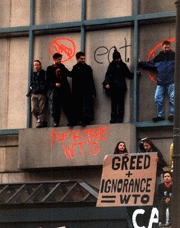 At about 3:30 p.m., word came from the cell phones that the
cops were attempting to push protesters out of the downtown core near
4th and Pine with a renewed barrage of tear gas, pepper spray, and
rubber bullets. Authorities had begun to worry about how downtown
workers -- many trapped in their stores and offices by protests and
street closures -- would be able to get home. Seattle Mayor Paul
Schell imposed a 7:00 p.m. to dawn curfew for a several block radius
around the city center.
At about 3:30 p.m., word came from the cell phones that the
cops were attempting to push protesters out of the downtown core near
4th and Pine with a renewed barrage of tear gas, pepper spray, and
rubber bullets. Authorities had begun to worry about how downtown
workers -- many trapped in their stores and offices by protests and
street closures -- would be able to get home. Seattle Mayor Paul
Schell imposed a 7:00 p.m. to dawn curfew for a several block radius
around the city center.
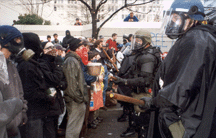 I had taken advantage of a break in the action to duck into a
drug store for cigarettes and fresh first aid supplies -- water, gauze
pads, paper towels, rubbing alcohol, and small squeeze bottles
perfectly sized for eye-rinsing. As I approached the corner of 4th, a
large number of people were fleeing a cloud of gas bigger than any we
had seen so far. Chris, a fellow "medic," had set up a first aid
station in the shelter of a nearby doorway. Although tear gas can be
quickly flushed away with water and the sting lessens with exposure to
the air, pepper spray is another matter. Not only does it cause
agonizing and prolonged eye pain, it also causes the skin to redden
and sting like a severe sunburn. Chris and I applied the recommended
remedy of mineral oil, rubbing alcohol, and water to the red faces of
dozens of demonstrators. As we worked, a woman came by with blood
streaming down her face from a jagged wound on her forehead -- she had
been hit at close range with a tear gas cannister. Another protester
had been shot in the mouth with a rubber pellet and appeared through
the blood to have several broken or missing teeth.
I had taken advantage of a break in the action to duck into a
drug store for cigarettes and fresh first aid supplies -- water, gauze
pads, paper towels, rubbing alcohol, and small squeeze bottles
perfectly sized for eye-rinsing. As I approached the corner of 4th, a
large number of people were fleeing a cloud of gas bigger than any we
had seen so far. Chris, a fellow "medic," had set up a first aid
station in the shelter of a nearby doorway. Although tear gas can be
quickly flushed away with water and the sting lessens with exposure to
the air, pepper spray is another matter. Not only does it cause
agonizing and prolonged eye pain, it also causes the skin to redden
and sting like a severe sunburn. Chris and I applied the recommended
remedy of mineral oil, rubbing alcohol, and water to the red faces of
dozens of demonstrators. As we worked, a woman came by with blood
streaming down her face from a jagged wound on her forehead -- she had
been hit at close range with a tear gas cannister. Another protester
had been shot in the mouth with a rubber pellet and appeared through
the blood to have several broken or missing teeth.
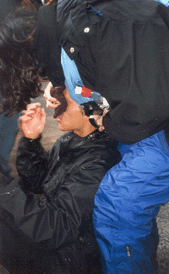
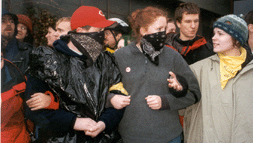 Determined to clear the downtown area by curfew, police
continued to rush and gas the protesters, pushing them back toward
Pine Street. As the twilight sky darkened, the clouds of gas reflected
the Christmas lights that ringed the central shopping plaza. On Pine,
the cops divided the crowd, sending some in the direction of the
waterfront and others toward highway I-5 and the residential Capitol
Hill neighborhood. As the demonstrators passed the convention center, a
speaker on nearby hotel balcony blared Jimi Hendrix's rendition of the
Star Spangled Banner.
Determined to clear the downtown area by curfew, police
continued to rush and gas the protesters, pushing them back toward
Pine Street. As the twilight sky darkened, the clouds of gas reflected
the Christmas lights that ringed the central shopping plaza. On Pine,
the cops divided the crowd, sending some in the direction of the
waterfront and others toward highway I-5 and the residential Capitol
Hill neighborhood. As the demonstrators passed the convention center, a
speaker on nearby hotel balcony blared Jimi Hendrix's rendition of the
Star Spangled Banner.
As the evening wore on, police continued to push demonstrators
up the slope toward the neighborhood. Despite the fact that the mayor
had declared I-5 as the western boundary of the curfew zone, the
police did not stop there. On Capitol Hill, residents and bar patrons
joined the protesters, and all were pushed further west by
intermittent barrages of concussion grenades and gas. Once the crowd
reached Broadway, a stand-off ensued, and some people began to block
the intersection with burning dumpsters. at around midnigt, arguments
were continuing about whether the group should stand its ground or go
home when I decided to call it a night.
12/1/99
On Wednesday morning, many store windows in the central
shopping area were boarded up, and several of yesterday's
demonstrators were helping sweep up broken glass and clean graffitti
off walls. About 200 protesters from the Direct Action Network decided
to stage a non-violent sit-in at Westlake plaza. But today, President
Clinton was in town, and Seattle officials were not in the mood to
deal with any dissent. Mayor Schell had declared a state of emergency,
called in the National Guard, made the blocks surrounding the WTO
meeting and Clinton's temporary residence at the Westin Hotel a "no
protest" zone, and banned the possession, sale, or transport of gas
masks. Faced with this affront, the focus of the protesters shifted
somewhat from the WTO to the actions of the police and the denial of
constititional rights.
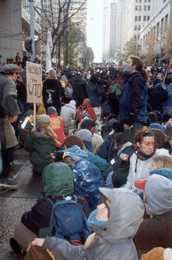
Soon the police moved in and -- in a drastic departure from
the day before -- arrestered the sitting demonstrators as well as many
bystanders who had no intention of getting arrested. Onlookers raised
peace signs and fists as the demonstrators were cuffed wth plastic
ties and loaded onto city buses pressed into service to carry them to
Sand Point, a decommissioned naval station several miles outside the
city. The arrestees later reported that they were not given food or
water and were denied access to their attorneys; the majority refused
to cooperate with the police and declined to give their names.
The mainstream media and many city officials repeatedly
lamented that the WTO and the surrounding events were interfering with
expected holiday shopping. Indeed, little commerce was conducted
Tuesday, Wednesday, or Thursday as Mayor Schell extended the previous
night's curfew into a general 24-hour restriction on any unauthorized
movement within the downtown core.
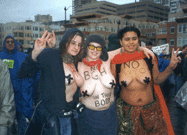 In the afternoon, under a drizzly sky, over 1,000 protesters
gathered to march from downtown to join a large labor rally on the
waterfront docks. Members of the steelworkers union were to dump steel
into the sound to protest international trade rules that hurt American
workers. Student activists, environmentalists, and anarchists alike
cheered the union leaders, but grew impatient when they were followed
by a string of long-winded legislators. Soon a chant of "Downtown!"
arose, as protesters decided to march once again toward the convention
center.
In the afternoon, under a drizzly sky, over 1,000 protesters
gathered to march from downtown to join a large labor rally on the
waterfront docks. Members of the steelworkers union were to dump steel
into the sound to protest international trade rules that hurt American
workers. Student activists, environmentalists, and anarchists alike
cheered the union leaders, but grew impatient when they were followed
by a string of long-winded legislators. Soon a chant of "Downtown!"
arose, as protesters decided to march once again toward the convention
center.
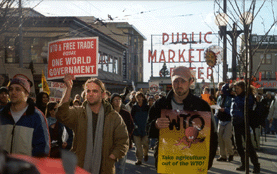 Some 4,000 people marched along the waterfront and through
Seattle's famed Pike Place Market. Although police presence had been
minimal at the docks, fully armed riot cops appeared seemingly out of
nowhere -- on foot, on motorcycles, in squad cars, and riding the
"peacekeeper" tanks -- as the crowd approached 1st Street. Once again,
it didn't seem to matter that this area was several blocks outside the
"no protest" zone declared by the mayor. "Flash bang" concussion
grenades, designed to frighten and disorient a crowd, were followed by
large amounts of tear gas. Unlike yesterday, though, today's crowds
near the marketplace included shoppers, bystanders, and people leaving
school or work. In the high winds, the gas could not be targeting and
blanketed a several-block area. At one point, bus drivers and
passengers were forced to abandon city buses as the acrid fumes filled
the vehicles.
Some 4,000 people marched along the waterfront and through
Seattle's famed Pike Place Market. Although police presence had been
minimal at the docks, fully armed riot cops appeared seemingly out of
nowhere -- on foot, on motorcycles, in squad cars, and riding the
"peacekeeper" tanks -- as the crowd approached 1st Street. Once again,
it didn't seem to matter that this area was several blocks outside the
"no protest" zone declared by the mayor. "Flash bang" concussion
grenades, designed to frighten and disorient a crowd, were followed by
large amounts of tear gas. Unlike yesterday, though, today's crowds
near the marketplace included shoppers, bystanders, and people leaving
school or work. In the high winds, the gas could not be targeting and
blanketed a several-block area. At one point, bus drivers and
passengers were forced to abandon city buses as the acrid fumes filled
the vehicles.
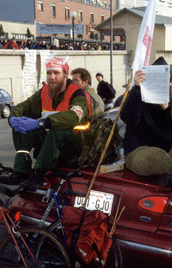 I stopped a volunteer medic on a bicycle flying a red cross
flag to collect more supplies. Two of us found a sheltered spot around
the corner from the melee and began helping people rinse their burning
eyes. With only a pair of sunglasses and a bandanna soaked in vinegar
to neutralize the acrid fumes, I found myself blinded and coughing as
the wind blew the gas towards us. After recovering for a moment, I
helped two Asian girls who said they were coming home from school. A
demonstrator across the street assisted an elderly man who had gotten
caught in the cross-fire. Although a faceful of tear gas is never
pleasant, it is especially shocking and terrifying for those who are
not expecting it and have no idea what hit them.
I stopped a volunteer medic on a bicycle flying a red cross
flag to collect more supplies. Two of us found a sheltered spot around
the corner from the melee and began helping people rinse their burning
eyes. With only a pair of sunglasses and a bandanna soaked in vinegar
to neutralize the acrid fumes, I found myself blinded and coughing as
the wind blew the gas towards us. After recovering for a moment, I
helped two Asian girls who said they were coming home from school. A
demonstrator across the street assisted an elderly man who had gotten
caught in the cross-fire. Although a faceful of tear gas is never
pleasant, it is especially shocking and terrifying for those who are
not expecting it and have no idea what hit them.
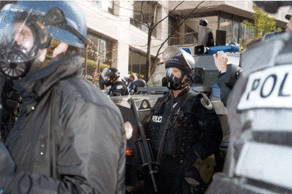 As the gas thickened, the crowd became disorganized. More riot
police arrived. They ordered people to disperse, but fired on them
with more and pepper spray before they had a chance to comply. Police
had seemingly blocked off all routes of escape. The small group I was
with attempted to turn up several side streets, only to find our exit
blcoked by yet another line of police. During the panic following one
grenade and gas blast, I found myself on the other side of a line of
cops and was able to get away. Others were not so lucky. One group of
about 100, finding themselves completely surrounded, sat in the street
and began chanting, "The whole world is watching!", echoing the
protesters at the 1968 Democratic National Convention in Chicago. As
they did then, the cops attacked the group and a large number of
arrests followed.
As the gas thickened, the crowd became disorganized. More riot
police arrived. They ordered people to disperse, but fired on them
with more and pepper spray before they had a chance to comply. Police
had seemingly blocked off all routes of escape. The small group I was
with attempted to turn up several side streets, only to find our exit
blcoked by yet another line of police. During the panic following one
grenade and gas blast, I found myself on the other side of a line of
cops and was able to get away. Others were not so lucky. One group of
about 100, finding themselves completely surrounded, sat in the street
and began chanting, "The whole world is watching!", echoing the
protesters at the 1968 Democratic National Convention in Chicago. As
they did then, the cops attacked the group and a large number of
arrests followed.
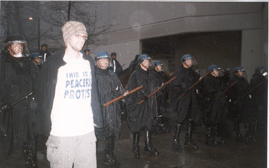
Many of the protesters who were not arrested made their way
East on Denny Way, well north of the so-called "no protest" zone. As
they had the previous evening, the police charged and gassed the
crowd, moving them once more toward Capitol Hill. At Broadway, the
demonstrators held a brief "victory celebration." The victory was
short-lived, however. When a police SUV tried to drive through the
crowd, several people began to pound and kick the vehicle, bringing an
immediate response from a line of riot police stationed a couple
blocks away. Once again, the tear gas flew, this time answered by a
volley of firecrackers, bottles, and debris.
Many angry neighborhood residents, some of whom felt the
effects of the tear gas in their homes, began to join the protesters
on the streets. Others left shops and restaurants, demanding that the
police "Get off our hill!" Although some neighbors also expressed
anger at the protesters, but most appeared to support the
demonstrators' right to engage in peaceful expression. As we watched
the standoff from an adjacent corner, I talked with a young
African-American high school student who lived a block away, after I
had washed tear gas out of her eyes. She said she was studying to
become a lawyer and hoped to fight against such civil rights abuses in
the future. I gave her a spent CS cannister that I found on the grass
at the community college; she wanted to take it to school the next day
to show her classmates and teachers. Wednesday night's standoff
continued for hours near the local precint headquarters -- and
involved the gassing of a local city council member who tried to
mediate between the cops and the crowd -- until the police were
finally able to disperse the crowd at about 2:00 a.m.
12/2/99
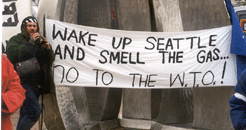
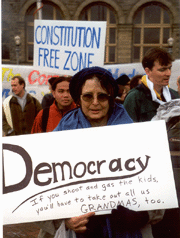 On Thursday, with the first dawning of the sun all week -- and
with the departure of the president -- everyone's spirits appeared to
have improved considerably. A morning free speech demonstration at the
community college on Capitol Hill was followed by an uneventful march
to join a waterfront rally supporting farmers and opposing genetically
engineered foods. A protest organizer later told me that the police --
apparently concerned about the public's negative reaction to their
actions the previous day -- had offered to escort the marchers
anywhere they wanted to go.
On Thursday, with the first dawning of the sun all week -- and
with the departure of the president -- everyone's spirits appeared to
have improved considerably. A morning free speech demonstration at the
community college on Capitol Hill was followed by an uneventful march
to join a waterfront rally supporting farmers and opposing genetically
engineered foods. A protest organizer later told me that the police --
apparently concerned about the public's negative reaction to their
actions the previous day -- had offered to escort the marchers
anywhere they wanted to go.
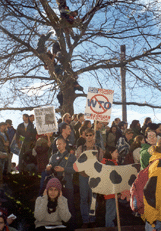 Following the farm rally, several thousand people marched
through Pike's Place market and headed back downtown toward the King
County jail at 4th and James to express their solidarity with those
arrested the previous two days. After surrounding the jail, the
demonstrators announced their intention to stay put until their
comrades were released. The scene became a true "festival of
resistance" as demonstrators played music and danced and Food Not
Bombs distributed food. The mayor and police officials agreed to
negotiate with representatives of the protesters for the release of
the arrestees. Negotiations were continuing when I left to catch the
last flight that night to San Francisco.
Following the farm rally, several thousand people marched
through Pike's Place market and headed back downtown toward the King
County jail at 4th and James to express their solidarity with those
arrested the previous two days. After surrounding the jail, the
demonstrators announced their intention to stay put until their
comrades were released. The scene became a true "festival of
resistance" as demonstrators played music and danced and Food Not
Bombs distributed food. The mayor and police officials agreed to
negotiate with representatives of the protesters for the release of
the arrestees. Negotiations were continuing when I left to catch the
last flight that night to San Francisco.
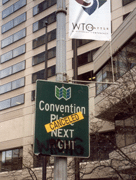 According to later reports, the demonstrators left before the
curfew that night, but many returned to continue their vigil the next
day. The arrestees continued their jail solidarity. Most were given
minor charges and were released by the end of the week, but must
return later for trials; a small number face more serious felony
charges. A fragile progressive activist coalition was built on the
basis of shared ideals rather than shared identities; it remains to be
seen what will become of this in the future. The actions of the police
so angered the citizens of Seattle that the chief of police was forced
to resign the following week. As for the WTO, their meetings ended
Friday in failure -- according to mainstream media reports -- with no
major agreements or schedules for further talks. The U.S. public can
no longer remain unaware of the once-secretive body that arbitrates
international trade.
According to later reports, the demonstrators left before the
curfew that night, but many returned to continue their vigil the next
day. The arrestees continued their jail solidarity. Most were given
minor charges and were released by the end of the week, but must
return later for trials; a small number face more serious felony
charges. A fragile progressive activist coalition was built on the
basis of shared ideals rather than shared identities; it remains to be
seen what will become of this in the future. The actions of the police
so angered the citizens of Seattle that the chief of police was forced
to resign the following week. As for the WTO, their meetings ended
Friday in failure -- according to mainstream media reports -- with no
major agreements or schedules for further talks. The U.S. public can
no longer remain unaware of the once-secretive body that arbitrates
international trade.
© 1999, Liz Highleyman
Liz Highleyman -- liz@black-rose.com

 As delegates arrived, demonstrators -- some dressed in sea
turtle costumes and others carrying giant puppets -- formed a human
barrier to deny them entry. Many began to climb on top of the Metro
buses that Seattle police had parked end-to-end around the
theater. Amazingly, authorities had neglected to secure a protected
means of entry for the delegates who began streaming toward the
theater individually and in small groups. This was to be the first
sign that city officials were woefully ill-prepared for what was to
come in the hours and days to follow.
As delegates arrived, demonstrators -- some dressed in sea
turtle costumes and others carrying giant puppets -- formed a human
barrier to deny them entry. Many began to climb on top of the Metro
buses that Seattle police had parked end-to-end around the
theater. Amazingly, authorities had neglected to secure a protected
means of entry for the delegates who began streaming toward the
theater individually and in small groups. This was to be the first
sign that city officials were woefully ill-prepared for what was to
come in the hours and days to follow.
 Several affinity groups -- small groupings of ten or so people
determined to interfere with the WTO meeting by means of direct action
-- stationed themselves in major downtown intersections around the
meeting sites, in some cases locking their arms together inside wire
tubes or chaining themselves to makeshift platforms. About 100 others
settled in for a sit-in outside the Sheraton convention center hotel
at 6th and Pike. Along with the many protesters who would not have
looked out of place at an anti-war demonstration three decades ago,
there was 50 to 100 protesters clad in hoods and bandanas, accompanied
by a small marching band wearing matching pink gas masks. From my
15-year acquaintance with the anarchist movement, I recognized the
"black bloc," a direct action tactic adopted from Germany in the
1980s; several of the anarchists joined the sit-in, facing off against
a line of cops in full riot gear.
Several affinity groups -- small groupings of ten or so people
determined to interfere with the WTO meeting by means of direct action
-- stationed themselves in major downtown intersections around the
meeting sites, in some cases locking their arms together inside wire
tubes or chaining themselves to makeshift platforms. About 100 others
settled in for a sit-in outside the Sheraton convention center hotel
at 6th and Pike. Along with the many protesters who would not have
looked out of place at an anti-war demonstration three decades ago,
there was 50 to 100 protesters clad in hoods and bandanas, accompanied
by a small marching band wearing matching pink gas masks. From my
15-year acquaintance with the anarchist movement, I recognized the
"black bloc," a direct action tactic adopted from Germany in the
1980s; several of the anarchists joined the sit-in, facing off against
a line of cops in full riot gear.

 Around 10:00 a.m., the demonstrators got louder and the police
appeared nervous. Some protesters tipped newspaper boxes into the
street to form makeshift barricades and began banging on them with
sticks. Soon a small tank dubbed "the peacekeeper" pulled up behind
the line of riot police. With no apparent provocation, the first of
many cannisters of tear gas flew toward the crowd.
Around 10:00 a.m., the demonstrators got louder and the police
appeared nervous. Some protesters tipped newspaper boxes into the
street to form makeshift barricades and began banging on them with
sticks. Soon a small tank dubbed "the peacekeeper" pulled up behind
the line of riot police. With no apparent provocation, the first of
many cannisters of tear gas flew toward the crowd.
 Some of the protesters had come prepared with goggles and gas
masks, while others covered their noses and mouths with bandannas
soaked in vinegar or baking soda. Many more, not expecting to be
gassed and unsure what was happening, panicked and tried to flee the
spreading cloud of gas and smoke. People with tears streaming down
their faces sought shelter in the doorway of an FAO Schwartz store as
others rinsed their eyes and burning skin with water. During a break
in the melee, I picked up several quarter- and half-inch rubber
pellets which police had shot at the crowd; as I would later see, the
pellets cause large bruises and can break teeth and penetrate skin at
close range.
Some of the protesters had come prepared with goggles and gas
masks, while others covered their noses and mouths with bandannas
soaked in vinegar or baking soda. Many more, not expecting to be
gassed and unsure what was happening, panicked and tried to flee the
spreading cloud of gas and smoke. People with tears streaming down
their faces sought shelter in the doorway of an FAO Schwartz store as
others rinsed their eyes and burning skin with water. During a break
in the melee, I picked up several quarter- and half-inch rubber
pellets which police had shot at the crowd; as I would later see, the
pellets cause large bruises and can break teeth and penetrate skin at
close range.
 Since the early-1990s, I had largely "retired" from direct
activism and focused my energies on writing; having traded in my
scruffy leather jacket for a North Face rain parka, I had come to
Seattle to cover the events as a freelance journalist. As the gassing
and shooting started, though, I began to think that my first aid
training would prove more useful. I had been a volunteer "medic" at
large events such as gay pride parades and pro-choice marches before,
but had never had to do more than apply a bandaid to a blister. Such
was not to be the case this week.
Since the early-1990s, I had largely "retired" from direct
activism and focused my energies on writing; having traded in my
scruffy leather jacket for a North Face rain parka, I had come to
Seattle to cover the events as a freelance journalist. As the gassing
and shooting started, though, I began to think that my first aid
training would prove more useful. I had been a volunteer "medic" at
large events such as gay pride parades and pro-choice marches before,
but had never had to do more than apply a bandaid to a blister. Such
was not to be the case this week.
 The tear gas used by the Seattle police -- CS gas, or
O-chlorobenzalmalononitrile -- is actually a cloud of tiny crystals
that irritate the mucous membranes. It causes the eyes to water, burns
the nose and throat, and its acrid odor leaves a bitter taste in the
back of the mouth. Those who come into contact with the gas -- even a
block away from where it was dispensed -- may be blinded and find it
hard to breathe; some also vomit. Flushing the eyes with water or a
saline solution is the best immediate remedy. Rubbing the eyes -- most
people's natural reaction -- only makes the burning worse.
The tear gas used by the Seattle police -- CS gas, or
O-chlorobenzalmalononitrile -- is actually a cloud of tiny crystals
that irritate the mucous membranes. It causes the eyes to water, burns
the nose and throat, and its acrid odor leaves a bitter taste in the
back of the mouth. Those who come into contact with the gas -- even a
block away from where it was dispensed -- may be blinded and find it
hard to breathe; some also vomit. Flushing the eyes with water or a
saline solution is the best immediate remedy. Rubbing the eyes -- most
people's natural reaction -- only makes the burning worse.
 Many demostrators, newscasters, and politicians would lament
in the days and weeks to followed that the violent actions of a few
marred the message of the many. Ironically, the anti-corporate and
anti-technology message of the militant anarchists was undermined in
turn when a small number of local youths not initially involved with
the anti-WTO protests looted the damaged storefronts, making off with
armloads of Nike logo merchandise, cell phones, and small electronics
equipment.
Many demostrators, newscasters, and politicians would lament
in the days and weeks to followed that the violent actions of a few
marred the message of the many. Ironically, the anti-corporate and
anti-technology message of the militant anarchists was undermined in
turn when a small number of local youths not initially involved with
the anti-WTO protests looted the damaged storefronts, making off with
armloads of Nike logo merchandise, cell phones, and small electronics
equipment.
 A midday, a large march of over 20,000 labor unionists and
supporters met up with the ongoing downtown demonstration after
marching from a rally at a stadium several blocks away. This new
influx swelled the crowd to some 50,000. Indeed, the incoming march
was so large that it was forced to separate into smaller columns to
approach the convention center. Demonstrators were euphoric when word
spread through the crowd that the morning's actions had resulted in
the cancellation of the WTO's opening ceremonies.
A midday, a large march of over 20,000 labor unionists and
supporters met up with the ongoing downtown demonstration after
marching from a rally at a stadium several blocks away. This new
influx swelled the crowd to some 50,000. Indeed, the incoming march
was so large that it was forced to separate into smaller columns to
approach the convention center. Demonstrators were euphoric when word
spread through the crowd that the morning's actions had resulted in
the cancellation of the WTO's opening ceremonies.
 At about 3:30 p.m., word came from the cell phones that the
cops were attempting to push protesters out of the downtown core near
4th and Pine with a renewed barrage of tear gas, pepper spray, and
rubber bullets. Authorities had begun to worry about how downtown
workers -- many trapped in their stores and offices by protests and
street closures -- would be able to get home. Seattle Mayor Paul
Schell imposed a 7:00 p.m. to dawn curfew for a several block radius
around the city center.
At about 3:30 p.m., word came from the cell phones that the
cops were attempting to push protesters out of the downtown core near
4th and Pine with a renewed barrage of tear gas, pepper spray, and
rubber bullets. Authorities had begun to worry about how downtown
workers -- many trapped in their stores and offices by protests and
street closures -- would be able to get home. Seattle Mayor Paul
Schell imposed a 7:00 p.m. to dawn curfew for a several block radius
around the city center.
 I had taken advantage of a break in the action to duck into a
drug store for cigarettes and fresh first aid supplies -- water, gauze
pads, paper towels, rubbing alcohol, and small squeeze bottles
perfectly sized for eye-rinsing. As I approached the corner of 4th, a
large number of people were fleeing a cloud of gas bigger than any we
had seen so far. Chris, a fellow "medic," had set up a first aid
station in the shelter of a nearby doorway. Although tear gas can be
quickly flushed away with water and the sting lessens with exposure to
the air, pepper spray is another matter. Not only does it cause
agonizing and prolonged eye pain, it also causes the skin to redden
and sting like a severe sunburn. Chris and I applied the recommended
remedy of mineral oil, rubbing alcohol, and water to the red faces of
dozens of demonstrators. As we worked, a woman came by with blood
streaming down her face from a jagged wound on her forehead -- she had
been hit at close range with a tear gas cannister. Another protester
had been shot in the mouth with a rubber pellet and appeared through
the blood to have several broken or missing teeth.
I had taken advantage of a break in the action to duck into a
drug store for cigarettes and fresh first aid supplies -- water, gauze
pads, paper towels, rubbing alcohol, and small squeeze bottles
perfectly sized for eye-rinsing. As I approached the corner of 4th, a
large number of people were fleeing a cloud of gas bigger than any we
had seen so far. Chris, a fellow "medic," had set up a first aid
station in the shelter of a nearby doorway. Although tear gas can be
quickly flushed away with water and the sting lessens with exposure to
the air, pepper spray is another matter. Not only does it cause
agonizing and prolonged eye pain, it also causes the skin to redden
and sting like a severe sunburn. Chris and I applied the recommended
remedy of mineral oil, rubbing alcohol, and water to the red faces of
dozens of demonstrators. As we worked, a woman came by with blood
streaming down her face from a jagged wound on her forehead -- she had
been hit at close range with a tear gas cannister. Another protester
had been shot in the mouth with a rubber pellet and appeared through
the blood to have several broken or missing teeth.

 Determined to clear the downtown area by curfew, police
continued to rush and gas the protesters, pushing them back toward
Pine Street. As the twilight sky darkened, the clouds of gas reflected
the Christmas lights that ringed the central shopping plaza. On Pine,
the cops divided the crowd, sending some in the direction of the
waterfront and others toward highway I-5 and the residential Capitol
Hill neighborhood. As the demonstrators passed the convention center, a
speaker on nearby hotel balcony blared Jimi Hendrix's rendition of the
Star Spangled Banner.
Determined to clear the downtown area by curfew, police
continued to rush and gas the protesters, pushing them back toward
Pine Street. As the twilight sky darkened, the clouds of gas reflected
the Christmas lights that ringed the central shopping plaza. On Pine,
the cops divided the crowd, sending some in the direction of the
waterfront and others toward highway I-5 and the residential Capitol
Hill neighborhood. As the demonstrators passed the convention center, a
speaker on nearby hotel balcony blared Jimi Hendrix's rendition of the
Star Spangled Banner.

 In the afternoon, under a drizzly sky, over 1,000 protesters
gathered to march from downtown to join a large labor rally on the
waterfront docks. Members of the steelworkers union were to dump steel
into the sound to protest international trade rules that hurt American
workers. Student activists, environmentalists, and anarchists alike
cheered the union leaders, but grew impatient when they were followed
by a string of long-winded legislators. Soon a chant of "Downtown!"
arose, as protesters decided to march once again toward the convention
center.
In the afternoon, under a drizzly sky, over 1,000 protesters
gathered to march from downtown to join a large labor rally on the
waterfront docks. Members of the steelworkers union were to dump steel
into the sound to protest international trade rules that hurt American
workers. Student activists, environmentalists, and anarchists alike
cheered the union leaders, but grew impatient when they were followed
by a string of long-winded legislators. Soon a chant of "Downtown!"
arose, as protesters decided to march once again toward the convention
center.
 Some 4,000 people marched along the waterfront and through
Seattle's famed Pike Place Market. Although police presence had been
minimal at the docks, fully armed riot cops appeared seemingly out of
nowhere -- on foot, on motorcycles, in squad cars, and riding the
"peacekeeper" tanks -- as the crowd approached 1st Street. Once again,
it didn't seem to matter that this area was several blocks outside the
"no protest" zone declared by the mayor. "Flash bang" concussion
grenades, designed to frighten and disorient a crowd, were followed by
large amounts of tear gas. Unlike yesterday, though, today's crowds
near the marketplace included shoppers, bystanders, and people leaving
school or work. In the high winds, the gas could not be targeting and
blanketed a several-block area. At one point, bus drivers and
passengers were forced to abandon city buses as the acrid fumes filled
the vehicles.
Some 4,000 people marched along the waterfront and through
Seattle's famed Pike Place Market. Although police presence had been
minimal at the docks, fully armed riot cops appeared seemingly out of
nowhere -- on foot, on motorcycles, in squad cars, and riding the
"peacekeeper" tanks -- as the crowd approached 1st Street. Once again,
it didn't seem to matter that this area was several blocks outside the
"no protest" zone declared by the mayor. "Flash bang" concussion
grenades, designed to frighten and disorient a crowd, were followed by
large amounts of tear gas. Unlike yesterday, though, today's crowds
near the marketplace included shoppers, bystanders, and people leaving
school or work. In the high winds, the gas could not be targeting and
blanketed a several-block area. At one point, bus drivers and
passengers were forced to abandon city buses as the acrid fumes filled
the vehicles.
 I stopped a volunteer medic on a bicycle flying a red cross
flag to collect more supplies. Two of us found a sheltered spot around
the corner from the melee and began helping people rinse their burning
eyes. With only a pair of sunglasses and a bandanna soaked in vinegar
to neutralize the acrid fumes, I found myself blinded and coughing as
the wind blew the gas towards us. After recovering for a moment, I
helped two Asian girls who said they were coming home from school. A
demonstrator across the street assisted an elderly man who had gotten
caught in the cross-fire. Although a faceful of tear gas is never
pleasant, it is especially shocking and terrifying for those who are
not expecting it and have no idea what hit them.
I stopped a volunteer medic on a bicycle flying a red cross
flag to collect more supplies. Two of us found a sheltered spot around
the corner from the melee and began helping people rinse their burning
eyes. With only a pair of sunglasses and a bandanna soaked in vinegar
to neutralize the acrid fumes, I found myself blinded and coughing as
the wind blew the gas towards us. After recovering for a moment, I
helped two Asian girls who said they were coming home from school. A
demonstrator across the street assisted an elderly man who had gotten
caught in the cross-fire. Although a faceful of tear gas is never
pleasant, it is especially shocking and terrifying for those who are
not expecting it and have no idea what hit them.
 As the gas thickened, the crowd became disorganized. More riot
police arrived. They ordered people to disperse, but fired on them
with more and pepper spray before they had a chance to comply. Police
had seemingly blocked off all routes of escape. The small group I was
with attempted to turn up several side streets, only to find our exit
blcoked by yet another line of police. During the panic following one
grenade and gas blast, I found myself on the other side of a line of
cops and was able to get away. Others were not so lucky. One group of
about 100, finding themselves completely surrounded, sat in the street
and began chanting, "The whole world is watching!", echoing the
protesters at the 1968 Democratic National Convention in Chicago. As
they did then, the cops attacked the group and a large number of
arrests followed.
As the gas thickened, the crowd became disorganized. More riot
police arrived. They ordered people to disperse, but fired on them
with more and pepper spray before they had a chance to comply. Police
had seemingly blocked off all routes of escape. The small group I was
with attempted to turn up several side streets, only to find our exit
blcoked by yet another line of police. During the panic following one
grenade and gas blast, I found myself on the other side of a line of
cops and was able to get away. Others were not so lucky. One group of
about 100, finding themselves completely surrounded, sat in the street
and began chanting, "The whole world is watching!", echoing the
protesters at the 1968 Democratic National Convention in Chicago. As
they did then, the cops attacked the group and a large number of
arrests followed.


 On Thursday, with the first dawning of the sun all week -- and
with the departure of the president -- everyone's spirits appeared to
have improved considerably. A morning free speech demonstration at the
community college on Capitol Hill was followed by an uneventful march
to join a waterfront rally supporting farmers and opposing genetically
engineered foods. A protest organizer later told me that the police --
apparently concerned about the public's negative reaction to their
actions the previous day -- had offered to escort the marchers
anywhere they wanted to go.
On Thursday, with the first dawning of the sun all week -- and
with the departure of the president -- everyone's spirits appeared to
have improved considerably. A morning free speech demonstration at the
community college on Capitol Hill was followed by an uneventful march
to join a waterfront rally supporting farmers and opposing genetically
engineered foods. A protest organizer later told me that the police --
apparently concerned about the public's negative reaction to their
actions the previous day -- had offered to escort the marchers
anywhere they wanted to go.
 Following the farm rally, several thousand people marched
through Pike's Place market and headed back downtown toward the King
County jail at 4th and James to express their solidarity with those
arrested the previous two days. After surrounding the jail, the
demonstrators announced their intention to stay put until their
comrades were released. The scene became a true "festival of
resistance" as demonstrators played music and danced and Food Not
Bombs distributed food. The mayor and police officials agreed to
negotiate with representatives of the protesters for the release of
the arrestees. Negotiations were continuing when I left to catch the
last flight that night to San Francisco.
Following the farm rally, several thousand people marched
through Pike's Place market and headed back downtown toward the King
County jail at 4th and James to express their solidarity with those
arrested the previous two days. After surrounding the jail, the
demonstrators announced their intention to stay put until their
comrades were released. The scene became a true "festival of
resistance" as demonstrators played music and danced and Food Not
Bombs distributed food. The mayor and police officials agreed to
negotiate with representatives of the protesters for the release of
the arrestees. Negotiations were continuing when I left to catch the
last flight that night to San Francisco.
 According to later reports, the demonstrators left before the
curfew that night, but many returned to continue their vigil the next
day. The arrestees continued their jail solidarity. Most were given
minor charges and were released by the end of the week, but must
return later for trials; a small number face more serious felony
charges. A fragile progressive activist coalition was built on the
basis of shared ideals rather than shared identities; it remains to be
seen what will become of this in the future. The actions of the police
so angered the citizens of Seattle that the chief of police was forced
to resign the following week. As for the WTO, their meetings ended
Friday in failure -- according to mainstream media reports -- with no
major agreements or schedules for further talks. The U.S. public can
no longer remain unaware of the once-secretive body that arbitrates
international trade.
According to later reports, the demonstrators left before the
curfew that night, but many returned to continue their vigil the next
day. The arrestees continued their jail solidarity. Most were given
minor charges and were released by the end of the week, but must
return later for trials; a small number face more serious felony
charges. A fragile progressive activist coalition was built on the
basis of shared ideals rather than shared identities; it remains to be
seen what will become of this in the future. The actions of the police
so angered the citizens of Seattle that the chief of police was forced
to resign the following week. As for the WTO, their meetings ended
Friday in failure -- according to mainstream media reports -- with no
major agreements or schedules for further talks. The U.S. public can
no longer remain unaware of the once-secretive body that arbitrates
international trade.